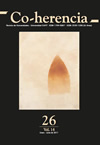Theology and aesthetic experience: the place of the image against the notion of Revelation in Martin Luther and John Calvin
Main Article Content
Keywords
Image, aesthetic experience, revelation, Martin Luther, John Calvin.
Abstract
This paper intends to argue that the Lutheran and Calvinist conception of Revelation makes it unnecessary to understand the image as a place of the sacred. The Lutheran postulate of justification by faith and the Calvinist postulate of double predestination lie in a very particular way of understanding Revelation, which divides the human being into two radically different dimensions, spiritual and bodily. This division has, in turn, a twin distinction: the separation between the public and the private. In view of this scheme, the image is in a paradoxical position and that can only be solved when the experience of the image starts to be conceived as an aesthetic experience, in other words, autonomous. This experience is reflected in the creation and appreciation or perception of the work.
Downloads
Download data is not yet available.
References
Belting, H. (1994). Likeness and Presence. A History of the Image before the Era of Art. Chicago - London: The University of Chicago Press.
Calvin, J. (2006a). Institutes of Christian Religion, Volume I. Louisville: The Westminster Press.
Calvin, J. (2006b). Institutes of Christian Religion, Volume II. Louisville: The Westminster Press.
Freedberg, D. (1986). Art and Iconoclasm, 1525-1580. The Case of the northern Netherlands. En J. P. Filedt, W. Halsema-Kubes & W. Th. Kloek (Redactie), Kunst voor de Beeldenstorm. Noordnederlandse Kunst 1525-1580: catalogus (pp. 69-84). Amsterdam: Rijksmuseum.
Gombrich, E. (1997). La historia del arte. Londres: Phaidon.
Hesselink, I. J. (2004). Calvin’s Theology. En D. K. McKim (Ed.), The Cambridge Companion to John Calvin (pp. 79-92). Cambridge: Cambridge University Press.
John of Damascus (1994a). John of Damascus, Exposition of the Ortodox Faith (rev. ca. 743). En H. Belting & E. Jephcott, Likeness and Presence. A History of Image before the Era of Art (pp. 503-504). Chicago - London: The University of Chicago Press.
John of Damascus (1994b). John of Damascus, Three Discourses on Sacred Images (ca. 730). En H. Belting & E. Jephcott, Likeness and Presence. A History of Image before the Era of Art (pp. 504-505). Chicago - London: The University of Chicago Press.
Karlstadt, A. (1994). Karlstadt, justifying the breaking of images (1522). En H. Belting & E. Jephcott, Likeness and Presence: A History of the Image before the Era of Art (p. 546). Chicago - London: The University of Chicago Press.
Largier, N. (2009). Mysticism, Modernity and the Invention of Aesthetic Experience. Representations, 105(1), 37-60.
Lutero, M. (1977a). Controversia sobre el valor de las indulgencias (1517). Las 95 tesis. En M. Lutero, Obras (pp. 62-69). Salamanca: Sígueme.
Lutero, M. (1977b). Controversia de Heidelberg (1518). En M. Lutero, Obras (pp. 74-85). Salamanca: Sígueme.
Lutero, M. (1977c). La libertad del cristiano (1520). En M. Lutero, Obras (pp. 155-170). Salamanca: Sígueme.
Lutero, M. (1977d). Artículos de Schmalkalda (1537-1538). En M. Lutero, Obras (pp. 332-357). Salamanca: Sígueme.
Luther, M. (1989). The Bondage of the Will. En M. Luther, J. Pelikan
& T. F. Lull, Martin Luther’s basic theological writings (pp. 138-170).
Minneapolis: Fortress Press.
Luther, M. (1994). Luther’s reply (1522, 1525). En H. Belting & E. Jephcott, Likeness and Presence: A History of Image before the Era of Art (pp. 545-546). Chicago - London: The University of Chicago Press.
Wriedt, M. (2003). Luther’s Theology. En D. K. McKim (Ed.), The Cambridge Companion to Martin Luther (pp. 86-119). Cambridge: Cambridge University Press.
Calvin, J. (2006a). Institutes of Christian Religion, Volume I. Louisville: The Westminster Press.
Calvin, J. (2006b). Institutes of Christian Religion, Volume II. Louisville: The Westminster Press.
Freedberg, D. (1986). Art and Iconoclasm, 1525-1580. The Case of the northern Netherlands. En J. P. Filedt, W. Halsema-Kubes & W. Th. Kloek (Redactie), Kunst voor de Beeldenstorm. Noordnederlandse Kunst 1525-1580: catalogus (pp. 69-84). Amsterdam: Rijksmuseum.
Gombrich, E. (1997). La historia del arte. Londres: Phaidon.
Hesselink, I. J. (2004). Calvin’s Theology. En D. K. McKim (Ed.), The Cambridge Companion to John Calvin (pp. 79-92). Cambridge: Cambridge University Press.
John of Damascus (1994a). John of Damascus, Exposition of the Ortodox Faith (rev. ca. 743). En H. Belting & E. Jephcott, Likeness and Presence. A History of Image before the Era of Art (pp. 503-504). Chicago - London: The University of Chicago Press.
John of Damascus (1994b). John of Damascus, Three Discourses on Sacred Images (ca. 730). En H. Belting & E. Jephcott, Likeness and Presence. A History of Image before the Era of Art (pp. 504-505). Chicago - London: The University of Chicago Press.
Karlstadt, A. (1994). Karlstadt, justifying the breaking of images (1522). En H. Belting & E. Jephcott, Likeness and Presence: A History of the Image before the Era of Art (p. 546). Chicago - London: The University of Chicago Press.
Largier, N. (2009). Mysticism, Modernity and the Invention of Aesthetic Experience. Representations, 105(1), 37-60.
Lutero, M. (1977a). Controversia sobre el valor de las indulgencias (1517). Las 95 tesis. En M. Lutero, Obras (pp. 62-69). Salamanca: Sígueme.
Lutero, M. (1977b). Controversia de Heidelberg (1518). En M. Lutero, Obras (pp. 74-85). Salamanca: Sígueme.
Lutero, M. (1977c). La libertad del cristiano (1520). En M. Lutero, Obras (pp. 155-170). Salamanca: Sígueme.
Lutero, M. (1977d). Artículos de Schmalkalda (1537-1538). En M. Lutero, Obras (pp. 332-357). Salamanca: Sígueme.
Luther, M. (1989). The Bondage of the Will. En M. Luther, J. Pelikan
& T. F. Lull, Martin Luther’s basic theological writings (pp. 138-170).
Minneapolis: Fortress Press.
Luther, M. (1994). Luther’s reply (1522, 1525). En H. Belting & E. Jephcott, Likeness and Presence: A History of Image before the Era of Art (pp. 545-546). Chicago - London: The University of Chicago Press.
Wriedt, M. (2003). Luther’s Theology. En D. K. McKim (Ed.), The Cambridge Companion to Martin Luther (pp. 86-119). Cambridge: Cambridge University Press.




